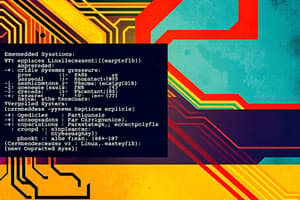Podcast
Questions and Answers
What role do embedded systems play in modern computing ecosystems?
What role do embedded systems play in modern computing ecosystems?
They bridge the physical and digital worlds by providing local processing and feeding data to more powerful systems for deeper analysis.
What is the significance of the power/energy wall in computing?
What is the significance of the power/energy wall in computing?
The power/energy wall limits the number of active circuit elements due to increased power consumption and thermal dissipation.
Explain the issue of data proliferation in modern technology.
Explain the issue of data proliferation in modern technology.
Data proliferation refers to the rapid growth of data generated and stored, making it complex for organizations to manage effectively.
What distinguishes embedded systems from general-purpose computers?
What distinguishes embedded systems from general-purpose computers?
What challenge arises from the limitations of CMOS technology?
What challenge arises from the limitations of CMOS technology?
Explain the significance of the shift from compute-centric to data-centric models in the ICT domain.
Explain the significance of the shift from compute-centric to data-centric models in the ICT domain.
How does the complexity of circuit elements change as transistor dimensions shrink?
How does the complexity of circuit elements change as transistor dimensions shrink?
What role do embedded systems play in edge computing?
What role do embedded systems play in edge computing?
What does the term 'dark silicon' refer to in chip design?
What does the term 'dark silicon' refer to in chip design?
Identify two major technological trends that are impacting embedded systems today.
Identify two major technological trends that are impacting embedded systems today.
What are the implications of compute-intensive application needs?
What are the implications of compute-intensive application needs?
What is meant by 'computing in memory' in the context of embedded systems?
What is meant by 'computing in memory' in the context of embedded systems?
Why is there a challenge in moving from invention to innovation in technology?
Why is there a challenge in moving from invention to innovation in technology?
How do embedded systems contribute to enhanced safety and privacy in modern computing?
How do embedded systems contribute to enhanced safety and privacy in modern computing?
Describe the computing continuum as it relates to embedded systems.
Describe the computing continuum as it relates to embedded systems.
What challenges does the high cost of developing new technology nodes present for embedded systems?
What challenges does the high cost of developing new technology nodes present for embedded systems?
What defines the connection between the virtual world and the physical world in IoT?
What defines the connection between the virtual world and the physical world in IoT?
How do cyber-physical systems differ from traditional IoT systems?
How do cyber-physical systems differ from traditional IoT systems?
What role do smart sensors play in the IoT ecosystem?
What role do smart sensors play in the IoT ecosystem?
What is the significance of machine-to-machine communication in mobile computing?
What is the significance of machine-to-machine communication in mobile computing?
How do cognitive computing and big-data analytics contribute to the functionality of cyber-physical systems?
How do cognitive computing and big-data analytics contribute to the functionality of cyber-physical systems?
In the context of IoT, what is an actuator and what role does it play?
In the context of IoT, what is an actuator and what role does it play?
What has changed in computing as we transitioned into the era of IoT and cyber-physical systems?
What has changed in computing as we transitioned into the era of IoT and cyber-physical systems?
Why is data analysis critical in the operation of IoT systems?
Why is data analysis critical in the operation of IoT systems?
What major industry changes in computing functionality occurred up to the 1980s?
What major industry changes in computing functionality occurred up to the 1980s?
How did the cost of computing change in the 1990s?
How did the cost of computing change in the 1990s?
What is the dark silicon problem?
What is the dark silicon problem?
Why is network-on-chip important for multi-core processors?
Why is network-on-chip important for multi-core processors?
How are future embedded systems expected to evolve in terms of networking?
How are future embedded systems expected to evolve in terms of networking?
What is expected to be paramount in the security of future embedded systems?
What is expected to be paramount in the security of future embedded systems?
In what ways are embedded systems expected to become more complex over the next decade?
In what ways are embedded systems expected to become more complex over the next decade?
What was the key driver behind the emergence of multi-core processors?
What was the key driver behind the emergence of multi-core processors?
What role does nanotechnology play in the development of future embedded systems?
What role does nanotechnology play in the development of future embedded systems?
Describe how MEMS contribute to the integration of functionalities in modern devices.
Describe how MEMS contribute to the integration of functionalities in modern devices.
Explain the importance of energy efficiency in the design of embedded systems.
Explain the importance of energy efficiency in the design of embedded systems.
What are the benefits of integrating diverse components such as biosensors and actuators in embedded systems?
What are the benefits of integrating diverse components such as biosensors and actuators in embedded systems?
How do advancements in communication protocols and RF technologies improve device connectivity?
How do advancements in communication protocols and RF technologies improve device connectivity?
Flashcards
Embedded Systems
Embedded Systems
Specialized computing systems designed for specific tasks within larger systems, often with real-time constraints.
Real-time constraints
Real-time constraints
Requirements for tasks to be completed within strict time limits.
Edge computing
Edge computing
Processing data closer to the source (sensors, devices) instead of sending it to a central location.
Computing continuum
Computing continuum
Signup and view all the flashcards
Data centric
Data centric
Signup and view all the flashcards
Dennard scaling limitations
Dennard scaling limitations
Signup and view all the flashcards
Moore's Law limitations
Moore's Law limitations
Signup and view all the flashcards
Computing in Memory
Computing in Memory
Signup and view all the flashcards
CMOS Technology Limits
CMOS Technology Limits
Signup and view all the flashcards
Dark Silicon
Dark Silicon
Signup and view all the flashcards
Data Proliferation
Data Proliferation
Signup and view all the flashcards
Compute-Intensive Applications
Compute-Intensive Applications
Signup and view all the flashcards
Hardware and Software Components
Hardware and Software Components
Signup and view all the flashcards
Connected Systems
Connected Systems
Signup and view all the flashcards
Global Interconnectivity
Global Interconnectivity
Signup and view all the flashcards
IoT (Internet of Things)
IoT (Internet of Things)
Signup and view all the flashcards
Cyber-Physical Systems
Cyber-Physical Systems
Signup and view all the flashcards
Smart Sensors
Smart Sensors
Signup and view all the flashcards
Gateways (IoT)
Gateways (IoT)
Signup and view all the flashcards
Remote Servers (IoT)
Remote Servers (IoT)
Signup and view all the flashcards
Actuators (Cyber-Physical systems)
Actuators (Cyber-Physical systems)
Signup and view all the flashcards
Data Analytics in IoT/CPS
Data Analytics in IoT/CPS
Signup and view all the flashcards
Distributed System (IoT)
Distributed System (IoT)
Signup and view all the flashcards
Dark Silicon Problem
Dark Silicon Problem
Signup and view all the flashcards
Multi-Core Processors
Multi-Core Processors
Signup and view all the flashcards
Network-on-Chip (NoC)
Network-on-Chip (NoC)
Signup and view all the flashcards
Networked Embedded Systems
Networked Embedded Systems
Signup and view all the flashcards
Security in Embedded Systems
Security in Embedded Systems
Signup and view all the flashcards
Future Embedded Systems
Future Embedded Systems
Signup and view all the flashcards
Evolution of Computing
Evolution of Computing
Signup and view all the flashcards
Historical Computing Functionalities
Historical Computing Functionalities
Signup and view all the flashcards
Giga-complexity
Giga-complexity
Signup and view all the flashcards
Heterogeneous systems
Heterogeneous systems
Signup and view all the flashcards
Software-driven solutions
Software-driven solutions
Signup and view all the flashcards
Seamless connectivity
Seamless connectivity
Signup and view all the flashcards
Energy efficiency
Energy efficiency
Signup and view all the flashcards
Study Notes
Introduction to Embedded Systems
- Embedded systems are specialized computing systems designed for specific tasks within larger systems.
- They are often hidden from the user and control hardware components.
- Unlike general-purpose computers, they are tailored for specific functions.
- Today's embedded systems often operate in real-time environments.
Shift from Standalone to Cloud-Connected Computing
- General public computing has transitioned from standalone desktops to mobile devices connected to the cloud.
- Increased access to vast amounts of information is a key driver.
- The end of Dennard scaling and Moore's Law necessitates new approaches for improving computing power and storage/communication.
- A move from compute-centric to data-centric computing is occurring.
- Computing is becoming a continuum, combining sensors, data fusion, processing, storage, and communication.
- Edge computing is gaining importance for improved safety, privacy, and cost.
- Embedded systems play a vital role in processing data at the edge.
Technological Limitations and Trends
- CMOS technology is approaching its limits.
- Technological advancements are likely to exist alongside CMOS rather than outright replacing it.
- Shrinking transistors, as an approach to performance improvements, has reduced speed.
- There is a power/energy wall due to increasing transistors, leading to greater power consumption.
- This limitation leads to the concept of dark silicon (inactive chip areas).
- Data proliferation (growth in data volume, variety, and velocity) makes data handling increasingly complex.
Application Needs for Embedded Systems
- Compute-intensive tasks are expected for embedded systems.
- Connection to other systems (wired or wireless) is essential.
- Many systems will be globally interconnected.
- Embedded systems will be physically entangled—interacting directly with the physical world.
- These systems are essential in the Internet of Things (IoT) and Cyber-Physical Systems (CPS)
- These systems handle vast amounts of data created by sensors to provide services.
- IoT systems use distributed, communicating devices where humans are not directly involved in the process.
Future of Embedded Systems
- Networked systems are evolving towards greater interconnectivity and distributed solutions.
- Security concerns are prominent in networked embedded systems.
- Increased complexity is expected, integrating diverse components, enhanced algorithms, and advanced capabilities.
- Emphasis on low-power designs will be crucial in many applications.
- Micro-Electro-Mechanical Systems (MEMS) are playing a growing role, enabling integration of mechanical and electrical components.
- Combining multiple functionalities and components into compact packages is crucial.
- Cyber-physical systems that directly interact with the physical world are also likely, characterized by actuators for physical changes, responding to data from the physical world.
Studying That Suits You
Use AI to generate personalized quizzes and flashcards to suit your learning preferences.




